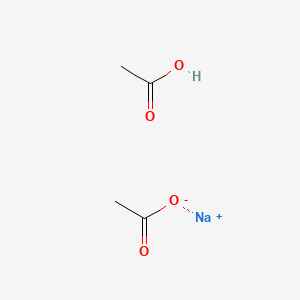ShanDong Look Chemical Co.,Ltd

Sodium Diacetate CAS 126-96-5 | Look Chemical
CAS No. 126-96-5
EINECS: 204-814-9
Chemical Name: Sodium Diacetate
Category: Food additives; Flavors and fragrances
Molecular Formula: C2H5NaO2
Molecular Weight: 84.05
Purity: 99%min
Brand Name: Look Chemical
Place of Origin: China
Name: Sodium Diacetate
CAS: 126-96-5
Purity: 99%min
MOQ: 1KG
Sodium Diacetate Chemical Formula

Basic Info
| CAS No: | 126-96-5 |
| MF: | C2H5NaO2 |
| Molecular Weight: | 84.05 |
| EINECS: | 204-814-9 |
| Appearance: | White powder |
| Product Name: | Sodium Diacetate |
| Other Name: | SDA; Sodium diacetate hydrate |
| Place of Origin: | China |
| Brand: | Look Chemical |
What is Sodium Diacetate?
The trade name of sodium diacetate is Vita-crop, which is a stable and low-priced food preservative. Sodium diacetate is also included in the list of synthetic food spices allowed to be used in Table B.3 of GB 2760-2014 “National Food Safety Standards for the Use of Food Additives”. It is designated as a safe substance by the U.S. Food and Drug Administration and has high anti-fungal properties. , antiseptic, fresh-keeping, improving palatability and increasing nutritional value.
Sodium diacetate is a white crystal with an acetic acid smell. It is hygroscopic and highly soluble in water. It decomposes when heated to above 150°C. It is flammable and stable under cool and dry conditions. Sodium diacetate mainly relies on decomposed molecular acetic acid to act as an antibacterial agent, and has good inhibitory capabilities against bacteria and mold. Sodium diacetate is an unspecified ADI (allowable daily intake) substance and is designated as a GRAS (generally recognized as safe) substance by the U.S. Food and Drug Administration.
Sodium diacetate is a molecular complex of sodium acetate and acetic acid, a white hygroscopic crystalline solid. It decomposes and becomes flammable when heated to above 150°C. 1 gram of sodium acetate is soluble in about 1 ml of water, and the pH value of a 10% aqueous solution is 4.5-5.0.
Sodium Diacetate Uses
Studies have shown that sodium diacetate mainly interferes with the interaction of enzymes by effectively penetrating into the cell wall of mold, inhibiting the production of mold, thereby achieving high-efficiency anti-mold, anti-corrosion and other functions. Sodium diacetate is effective against Aspergillus niger, Rhizopus niger, The inhibitory effect of Aspergillus flavus and Trichoderma viride is better than that of potassium sorbate.
- Adding 0.1-0.2% 1-2 kg/ton SDA to feed can effectively prevent feed mildew and extend the feed storage period by 1-2 months; adding 0.1-0.3% SDA to compound feed can prevent feed corrosion and preserve freshness 3 -5 months.
- Use as nutritional flavoring agent
Adding 0.05-0.2% SDA to pellet compound feed can increase the protein utilization rate in the feed by 11%, fish weight gain by more than 10%, and piglet weight gain by 6-8%. Adding an appropriate amount to milk compound feed can effectively Increase milk protein content of dairy cows. - Use as disinfectant
Adding 0.1-0.2% SDA to aquatic feed can effectively prevent and treat fish diseases caused by homologous microorganisms, and can be used as a fish pond clarification and disinfectant; adding 0.05-0.3% SDA to poultry feed can prevent and treat chicken It can prevent diarrhea and increase the survival rate of brooding period by more than 10%. - Application of sodium diacetate in weaned piglet feed
Adding 0.3% sodium diacetate to the feed increased the daily weight gain of weaned piglets by 10.8% compared with no addition, with a significant difference; it also had a significant impact on the daily feed intake of weaned piglets. Adding sodium diacetate can significantly improve the feed conversion rate of weaned piglets (increased by 10.5%). It may be mainly that sodium diacetate improves the utilization rate of feed nitrogen and energy.
References
Sodium diacetate – WikiPedia
Characteristics and antifungal action mechanism of sodium diacetate
Sodium Diacetate for Sale
Practical Application of Sodium Diacetate in Food
The usage amount of sodium diacetate in prepared meat products and cooked meat products is 3.0 g/kg.
The amount of sodium diacetate added to non-alcoholic beverages is 0.05%-0.06%; the amount added to soda drinks is 0.04%-0.05%; the amount added to fresh orange juice, hawthorn juice, etc. is 0.04%, which can be stored for 6 months.
Soy sauce is added with 0.3% sodium diacetate. It can be stored for 3 months in high temperature seasons without mold.
Sauces: Since sauces are relatively viscous, sodium diacetate is not easy to disperse evenly in them. You can add 5% sodium diacetate aqueous solution under heating before leaving the factory.
For pickled vegetables, sodium diacetate can be dissolved in soy sauce and added at an amount of 3 g/kg.
For pickles with distiller’s grains, sodium diacetate can be dissolved in shochu or cooking wine and added in an amount of 2 g/kg.
Vinegar pickled vegetables are added directly at a dosage of 1 g/kg.
To pickle cucumbers, beetroots and other pickled vegetables, add the same amount of sodium diacetate as salt to the vinegar containing salt. To prevent the pickle brine from becoming cloudy, you can first dissolve the salt, spices and sodium diacetate in water and then add vinegar. .
The pickling operation must be very careful to prevent contamination of bacteria, otherwise the jar will rot. If sodium diacetate is used, the kimchi can be made without a kimchi jar, and kimchi can be made at any time across the country. Reference preparation method: add cold boiled water to dissolve sodium diacetate in a container to make a 5% aqueous solution, add salt, seasonings, etc., and then add washed vegetables such as kohlrabi, cucumbers, peppers, celery, cowpeas, etc. It can be guaranteed not to grow pickled for 2 months and taste delicious (vegetables must be submerged under water and cannot be exposed to the water). In addition, if the kimchi manufacturer produces bagged kimchi, 3 grams/kg (based on the weight of fresh vegetables) of sodium diacetate should be added to ensure that it will not become moldy or spoilage for 6 months.
After the pickled cabbage becomes sour in the vat, dissolve sodium diacetate with a small amount of water and pour it evenly into the vat. The dosage is 2 g/kg (based on the weight of fresh vegetables). Add this product while pickling the vegetables. Can. After using this product, at room temperature below 20℃-25℃, the sauerkraut will not grow pickled, will not rot, and will not smell bad. The sauerkraut will still be crispy and crispy when pickled in the second year. The same method can be used to pickle vegetables such as cucumbers and vegetables. Chili, radish, celery, mustard, shepherd’s purse, cowpea and other marinated acid pickled products.
Assorted Sauces Pickles are produced in one season and supplied year-round. The pickles are often turned over in a salt brine with a high salt content. They usually become pickled and taste very salty. Especially the bagged sauces will become moldy within 25 days. If 3 grams/kg sodium diacetate is added and the pickles are turned as much as possible when they are sold, they can be kept fresh for 4 months.
Fish products The pH value of fish cake products should be between 6.8 and 7.2. Lowering the pH value will affect the elasticity of fish cakes, so the dosage of sodium diacetate cannot exceed 2 g/kg.
Add 3-4 g/kg of sodium diacetate to the fish sausage and store it at 30°C. It will not deteriorate after three weeks of storage, while the reference substance will deteriorate in one week. When the pH value of the fish sausage is adjusted to less than 6, it will deteriorate at 10°C-15 ℃ temperature, storage for 3 months without deterioration.
Dried fish products: Dried fish products with high dryness and moisture content below 30% will not go rancid, but mold will occur. The dosage of sodium diacetate is 2 g/kg.
Smoked fish: Spray 10%-12% sodium diacetate solution on smoked fish products. The spraying process can be before, during or after smoking.
Fish and shrimp boiled in soy sauce can be stored at 10℃-15℃ without deterioration for 3 months after adding sodium diacetate in an allowable amount of 2g/kg.
Wash fresh fish, fresh shrimps and other aquatic products and soak them in 10% sodium diacetate aqueous solution for 30 minutes, then drain the solution and refrigerate the fish to keep the freshness of the fish unchanged and at a temperature of 30°C Store it for a week and the flavor will remain unchanged.
Pastries, biscuits, and bread: Sodium diacetate can be added directly to flour or dough at an amount of 0.4% (based on flour weight).
Sodium diacetate is added when soybeans are crushed, and the addition amount is 0.2% (based on the weight of soybeans). It has unique effects that other antifungal agents do not have.
Sodium diacetate has excellent anti-mildew effect when used in grains, cereals, rice noodles and their products.
By adding 0.1%-0.8% sodium diacetate to grains with a moisture content of about 21.5%, the storage period of grains can be extended from the original 90 days to more than 200 days.
Sodium diacetate is used in rice and flour products to have a good anti-mold and fresh-keeping effect. Apply it to the preservation of Guangdong rice noodles (cut rice noodles). Adding 0.2% sodium diacetate to the rice slurry can extend the shelf life of the steamed rice noodles by 1 day at room temperature. If sodium diacetate and propionic acid are combined Calcium is mixed at a ratio of 1:1, and the same amount can extend the shelf life of rice noodles by more than 2 days.
Sodium diacetate also has good anti-mold and anti-corrosion effects on rice and flour products such as corrugated noodles, yuba, and dried tofu.
Sodium diacetate is used in edible syrups. Adding 0.1% sodium diacetate can prevent syrup from becoming moldy.
Antifungal Effect of Sodium Diacetate
As a feed additive, sodium diacetate is harmless to humans and animals, has no residue, has good palatability, and has the function of increasing nutritional value and feed quality. In addition, the antifungal effect of sodium diacetate is better than that of currently used propionate.
Under natural conditions, sodium diacetate will slowly release acetic acid, which can effectively penetrate into the cell wall of mold tissue cells, interfere with the interaction of enzymes between cells, and denature intracellular proteins. Adding sodium diacetate to feed can reduce water activity. It denatures bacterial proteins and achieves the purpose of dehydration and death of bacterial cells by changing cell morphology and structure, thereby playing an antibacterial and anti-fungal role. Acetic acid is an important precursor for fat synthesis in ruminants. It is beneficial to the formation of short-chain fatty acids in milk fat and improves the milk fat rate.
Feeding dairy cows with 0.1%-0.15% sodium diacetate and silage can increase feed intake by 10%-20%, milk production by 13%-20%, and milk fat rate by 0.2%. When feeding cows, broilers, and piglets with feed added with 0.1%-0.2% sodium diacetate, the weight gain can be increased by 6%-10%, the feed conversion rate can be increased by about 10%, and the survival rate of poultry during the brooding period can be increased by 10%.
Sodium diacetate has a strong ability to kill mold and is used to inhibit grain mildew. According to literature reports, adding 0.1% to 0.8% sodium diacetate to grains with a moisture content of 21.5% can extend the storage period from 90 days to 280 days, and adding 0.5% to 1.0% to grains with a moisture content of 17% to 33% A compound mold growth inhibitor composed of 77.6% sodium diacetate, 20% sorbitol and 2.4% anti-caking agent has shown no mold formation when stored at 21 to 27°C and humidity of 70% to 85% for 90 days. The anti-mold effect of adding 0.75% sodium diacetate to grains with a moisture content of 22% is 20 times that of not adding sodium diacetate.
Sodium diacetate added to silage can effectively inhibit the growth of mold, improve the quality of silage, and achieve the purpose of preservation. Adding 0.2% to 0.4% sodium diacetate to silage can extend the storage period of silage at pH=4.08. More than 3 weeks. According to Ge Zhenghua (1993), about 0.2% SDA was added to silage ryegrass. After 150 days of storage, the total number of molds in the test group was only 10% of that in the control group, and basically no mold occurred during the use period.
Learn More
Professional Sodium Diacetate Supplier
As a professional chemical supplier, we have ten years of chemical supplier experience, more professional and reliable, 24 hours service. Provide free samples.If you want to know more, please come to consult us.
Service
Pre-Sales Service
* Prompt reply and 24 hours online, professional team to provide best price and high quality product.
* Sample testing support.
* Every batch of products will be tested to ensureits quality.
* The packing also can be according the customers` requirment.
* Any inquiries will be replied within 24 hours.
* We provide Commerical Invoice, Packing List, Bill of loading, COA , Health certificate and Origin certificate. If your markets have any special requirements, let us know.
After-Sales Service
* The fact of logistics information monitoring.
* Any questions about the product can be consulted at any time.
* Product has any problem can return.
1. ≤50kg, Express delivery recommended, usually called as DDU service;
2. ≤500kg, Air shipping recommended, usually called as FOB, CFR, or CIF service;
3. >500kg, sea shipping recommended, usually called as FOB, CFR, or CIF service;
4. For high value products, please select air shipping and express delivery for safe.
Do you accept sample order?
We will make samples before mass production, and after sample approved, we’ll begin mass production. Doing 100% inspection during production, then do random inspection before packing.
What’s your MOQ?
Our MOQ is 1kg. But usually we accept less quantity such as 100g on the condition that sample charge is 100% paid.
Is there a discount?
Different quantity has different discount.
How to confirm the product quality before placing orders??
You can get free samples for some products,you only need to pay the shipping cost or arrange a courier to us and take the samples. You can send us your product specifications and requests,we will manufacture the products according to your requests.- Do you supply product report?Yes. We’ll give you product analysis report before shipping.
Packaging and Shipping of Sodium Diacetate







